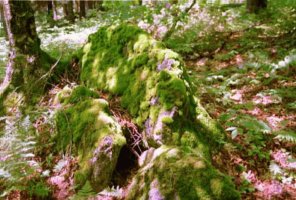|
Bryophyte Research Group
Dr. Kate Frego, University of New Brunswick – Saint John, Department
of Biology, (email: frego@admin1.csd.unbsj.ca)
Nicole Fenton, UNBSJ Biology) (email: p17p1@unb.ca)
Amy Ross, UNBSJ Biology, (email: l4d0@unb.ca)
Bryophytes (mosses and liverworts) influence soil temperature, moisture
and nutrient retention, and influencing the habitat for vertebrates,
invertebrates and tree seedlings, however the species composition of
the bryophyte community is poorly documented for New Brunswick, and
little is known of its response to anthropogenic disturbance regimes.
In order for species diversity to maintained in a highly managed landscape
such as the forests of New Brunswick, species must be able to either:
(1) survive the disturbance event as adults, (2) survive as propagation
units (propagules) ,or (3) colonize the disturbed area as diaspores.
To assess the short term responses to forestry disturbance, we are building
on work that began in 1995 at Hayward Brook, which tracked the responses
of permanent quadrats. Results of our earlier work indicate that many
species are not able to survive the disturbance event (42 of 76 species
were lost from the quadrats), and that species found in the soil propagule
bank are not those that were in the community pre disturbance. Therefore
the soil propagule bank would not be able to act as a source of propagules
for forest floor species. However current work indicates that some of
these "lost"species survive in refugia (undisturbed patches within the
cut area), and these individuals may act as sources of reproductive
units to colonize the disturbed area. We are documenting the characteristics
of two types of putative refugia: "tree islands" and riparian buffers.
This research will lead to suggestions to limit the damage done to the
bryophyte community during harvest and increase restoration of pre harvest
biodiversity in managed forests.
Over the long term, bryophyte biodiversity is not maintained in managed
landscapes: several decades after forest harvest, we found that 1/3
of the species characteristic in naturally regenerating stands were
missing from the forest floor of plantations. Are the differences in
species composition due to (1) differences in critical habitat features
(e.g. decaying wood as a substrate), or (2) bottle-necks in the regeneration
process (e.g. lack of propagation units)? We are currently comparing
environmental features of plantations vs naturally regenerating forests,
and testing them for correlation with species composition. In the coming
field season, we will be examining the relationship among the bryophyte
community and its regeneration sources, i.e. aerial diaspore "rain"
(spores) and buried propagule bank (spores and fragments). Fine-scale
variability and similarity among the community and both regeneration
sources will be determined. Ultimately, these results will determine
the potential for the pre harvest community to re-assemble based on
propagule availability.

Moss covered boulder, Fundy National Park
Click
to Return to the Main Page
|



